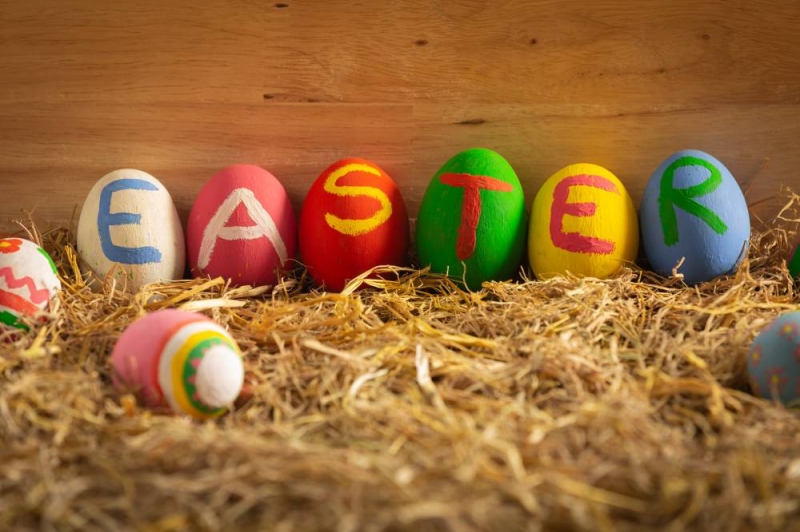Every year, on a Sunday in spring, one can observe the same scene all over Germany: children from toddlers to teens busily running around in houses, gardens, public parks or even in zoos. They all seem to be looking for something..
. Whatever it is they are searching for, it must be very important. Everybody is deeply engaged, frantically looking for something that seems lost – a valuable item, surely.

Even parents and grandparents join in, sometimes advising or directing the kids, taking pictures and videos – maybe as legal documentation and for later proof of the whole thing? So, what could they all have lost so suddenly? Why don't only the youth of Germany but also the youngsters of many other European countries unite in such a motivated search on that one particular Sunday morning? Let's reveal the secret: Nothing is lost but there is much to gain. The supposed valuables to retrieve are chocolates and candies, sometimes hard-boiled eggs, and even small books, toys or other surprises! And whoever finds them gets to keep them – it's Easter Sunday in Germany and the search is on for "Easter Eggs"! The story goes like this: On the night before Easter Sunday, the Easter Bunny rushes around, hiding sweet surprises for children to discover the next day. The bunny must be very organised, maybe similar to Santa Claus during Christmas.
Like Santa, the Easter Bunny only has one night to travel across Germany, reaching Hamburg in the north, Munich in the south, travelling from Frankfurt on the river Main to its namesake city of Frankfurt on the river Oder and each and every settlement in between. While it is not entirely clear where this tradition originated, one can be sure that it is a blend of various rituals, traditions and symbols. The hare itself was a symbol in pre-Christian Germany and a messenger of the goddess "Ostara", whose name could very likely have been the origin of the German word for Easter: "Ostern".
But hares also symbolise spring, the season when young bunnies can be seen roaming around all over the German countryside. Regarding the famous Easter Eggs, the story is a bit more known: For centuries, eating eggs was forbidden during the fasting period leading up to Easter. Therefore, eggs accumulated and were often coloured to distinguish them according to their age.
Eggs also served as symbols of fertility and rebirth and were often blessed by the church. They also then were coloured to differentiate them from the ones that were not blessed. Additionally, the time around Easter marks the end of winter and the arrival of spring – a major event to celebrate in the past, especially since there was no proper heating in houses and food supplies were limited during the long winter months.
Today, the religious significance of Easter is not as prominent as it once was, but it remains a Christian holiday. It is an occasion for family and friends to gather and enjoy an extended weekend, as both Friday and Monday are public holidays in Germany. Wherever people meet, live, or work one can find the typical Easter Bouquet: a bunch of fresh flowering twigs, beautifully decorated with Easter Eggs.
Initially, these are regular chicken eggs, but they are carefully blown out and emptied through holes in the top and the bottom of the eggshell. The contents can later be used for baking or an omelet. The emptied eggs are then decorated with oil- or water-based paints, pencils, wax, or any other medium the artist chooses.
The designs can range from anything that comes to mind: portraits of family members, hobbies, flowers, animals, triangles, dots, stars or suns-there are no rules. Children decorate the eggs with no judgment from anyone but themselves and their immediate family, who will always appreciate the effort. In fact, decorating Easter Eggs is often a family affair, and together, the decorated eggs are then hung on the twigs of the Easter Bouquet.
But there are also professional Easter egg painters. A region particularly known for this is the "Spreewald," located about an hour's drive south of Berlin. The Spreewald is home to the Sorbs, an ethnic and cultural minority in Germany with their own language, closely related to other Eastern European and Slavic tongues.
They are known for their unique traditions, which they preserve and cherish. The art of decorating Easter Eggs is part of this tradition, and the Sorbs have perfected it over generations. While the older generations typically safeguard these age-old traditions, many younger Sorbs also take part in the process.
Museums, workshops for tourists and even competitions and festivals are held each year, centered around Easter Eggs. Which egg is the most beautiful is subjective, of course, as beauty lies in the eye of the beholder. Everyone has a different preference, and the artist is always most fond of their own work.
Easter Eggs are no exception, and all are admired, regardless of whether the artist is two or 100 years old. In the end, Easter carries many meanings and boasts a variety of traditions, allowing everyone to choose how they wish to celebrate. Whether it's the religious aspect, the arrival of spring or simply the opportunity to gather with family and friends-it's all part of the Easter spirit.
And, of course, there's always the candy. Meanwhile, the children were busy finding candy, hidden in nests of grass, or small pre-packed baskets. Occasionally, they may even discover remnants from last year's hunt- a piece of chocolate that was hidden too well to be found before.
And sometimes, to everyone's surprise, children may uncover their mother's lost glasses or their father's missing wallet. And at that moment, everyone will joyfully call out: Happy Easter!.
Politics

What are they searching for?: It's all part of the Easter spirit

Every year, on a Sunday in spring, one can observe the same scene all over Germany: children from toddlers to teens busily running around in houses, gardens, public parks or even i...













